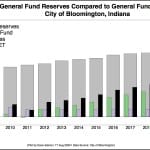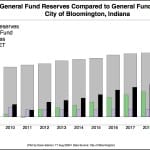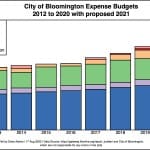Bloomington budget hearings draw remarks on convention center expansion, farmers market, anti-racism training, policing



On Monday, details of Bloomington mayor John Hamilton’s 2021 proposed budget were released, putting some meat on the bones that were previewed to the media on Friday.
Hamilton delivered remarks to the city council on Monday night for the first night of a four-day series of departmental budget hearings, which wrap up on Thursday.
If the focus is narrowed just to the general fund, the picture looks the same as last year, with a couple of caveats.
Proposed for this year is $48.69 million which is a 4.1 percent increase, compared to last year’s $46.76 million. But adjusting for a $2 million package of “Recover Forward” initiatives and a decrease in property tax cap expenditures of $193,772, the proposed budget works out to a zero percent increase (out to two decimal places).
The mayor’s proposed budget draws on $3.3 million in reserves—$2 million from the rainy day fund and $1.3 in fund balances. By the end of 2022, Hamilton expects to have drawn down total reserves from four months’ worth of operating expenses to three months’ worth.
“Recover Forward” is a label for Hamilton’s program of activities to try to help the local economy recover from the impact of the COVID-19 pandemic.
In Hamilton’s remarks to the city council on Monday night, Hamilton drew an analogy to Roosevelt’s New Deal proposal, made in a May 2, 1932 speech by quoting FDR’s remarks: “The country needs and, unless I mistake its temper, the country demands bold, persistent experimentation It is common sense to take a method and try it: If it fails, admit it frankly and try another. But above all, try something.”
The overall budget, not including City of Bloomington Utilities or Bloomington Transit, shows a 3.6 percent reduction, from last year’s approved number of $98.66 million, to this year’s proposed $95.11 million. That’s mostly due to a $5 million decrease in the food and beverage tax fund.
The reduction in planned food and beverage tax expenditures, compared to last year’s planned expenses, stems from a pause in the convention center expansion project, which is still in the planning stages. The primary statutory purpose of the one-percent food and beverage tax, which has been collected since early 2018, is to pay for a convention expansion.
The need for a pause in the project stems from the COVID-19 pandemic’s impact on food and beverage tax revenue.
The timeframe of the convention center expansion delay, as long as five years, was the subject of some remarks by city staff. The project drew public comment on the question of whether it should go forward at all.
Other specific topics drew some attention on Monday, even if they had just indirect connections to the departmental budgets presented that night. Among them were the farmers market, anti-racism training, and policing.
Specific councilmember interests that got some air time were city council chambers technology upgrades (Steve Volan) and a drone-based deer census (Dave Rollo).
Departmental budgets presented on Monday were those for human resources, city clerk, legal, information and technology services, city council, controller, and office of the mayor.
Convention center expansion
When city controller Jeff Underwood described the impact of COVID-19 on revenues, he pointed to a decrease in the rate of growth for property tax revenues. He also described a possible hit of 10 to 20 percent on local income tax revenue starting in 2022. The gas tax has already taken a hit, he said.
Food and beverage tax revenues for the last three months are down 40 percent compared to last year.
About the longer-term future, Underwood said, “I think you’re going to see at least a five-year impact on food and beverage, which will certainly impact the ability to ever expand the convention center. I think that’ll have a longer timeframe of probably five to seven years, especially if we continue to see the pandemic continue on.”

Councilmember Isabel Piedmont-Smith asked Underwood if there was “some metric or some goalpost” that would determine whether to continue to pursue the convention center expansion.
Underwood said the revenues would continue to be monitored. He pointed out that some of the accumulated balance of food and beverage revenues had been loaned out to local businesses and nonprofits as a part of the city’s program to help them recover from the impact of COVID-19.
Underwood said, “A lot of it will depend on when we come when we come out of this. If it’s prolonged, it’s going to push that down the road.” Underwood advocated for pursuing the project: “The expansion would spur investment back into the very people that we’re trying to help with the food and beverage people. So we continue to think it’s a needed function. .. [I]t will have strong demand for it because Bloomington is a destination.”
Underwood said the project has been put off for now as the city addresses other issues but concluded, “We have no plans not to pursue it.”
During public commentary, Daniel Bingham weighed in against pursuing the convention center project, analyzing it in the context of climate change and greenhouse gas emissions as “high-carbon infrastructure.”
About a convention center, Bingham said, “It’s dependent on people engaging in long-distance travel, which is something that’s going to have to drop off a bunch in a low-carbon world.” Bingham said the effects of climate change be more severe than those caused by COVID-19.
“If you think these last few months of COVID have been terrible, we are facing far worse, if we do not act now on climate change. What we are living through now will feel like a cakewalk,” Bingham said.
Farmers market
As a part of her presentation of the legal department’s budget on Monday, the city’s corporation counsel, Philippa Guthrie, mentioned litigation that the department is currently handling. Among those cases is one involving a farmers market vendor, Schooner Creek Farm (SCF), that filed suit against the city. Bloomington has filed a counter claim.
It was in 2019 when protestors showed up at the market on several Saturdays to call for a boycott of SCF, after local activists pointed to evidence that SCF owners espoused white-supremacist views. The current case management order shows a trial scheduled more than a year from now, in December 2021.
In connection with the legal department’s budget presentation, councilmember Isabel Piedmont-Smith, who chaired the evening’s proceedings, commented on the farmers market: “It may be time to think about getting out of the farmers market business. Because I don’t think there’s any way we can win and we can keep people feeling safe at our market.”
Her colleague Dave Rollo responded with a brief comment of his own: “I respectfully disagree. I think that the administration is doing the appropriate thing in maintaining a public space, which we seem to be running out of in our society, and so I appreciate their efforts.”
The budgetary context for the city council to decide the future of the farmers market could be when it comes time to review the parks and recreation department’s budget. The parks department budget presentation is scheduled for Wednesday.
The board of park commissioners gets its presentation a day earlier, on Tuesday. The farmers market falls under the community events part of the parks and recreation budget. The farmers market does not appear in the list of goals for 2021, but is included in the description of activities under community events.
Anti-racist training
In his remarks to the council, mayor Hamilton talked about anti-racist training that the city would be pursing.
When the city council’s own budget came up, councilmember Jim Sims asked about funding for anti-racist training. Sims alluded to the fact that the city has issued a request for qualifications (RFQ) for an anti-racist training consultant, saying that he knew nothing had yet been decided. Still, Sims said, he anticipated some decision would be made.
Council administrator/attorney Stephen Lucas told Sims that $800 in training and travel related expenses are in the budget for each councilmember. Lucas said that citywide training that’s done through the human resources department is often made available to all employees. And councilmembers would be included in that, Lucas said.
In past years, Lucas said, the council training budget has included things like newly-elected officials training, and various conferences. Councilmembers have often sent one member to a conference to report back to the full council, Lucas said.
During public commentary Cathi Crabtree said the council should accept the Black Lives Matter B-town core council’s call to participate in that group’s anti-racism training. “This will allow authentic anti-racism policy discussions,” Crabtree said.
Policing
Crabtree’s remarks on anti-racist training came in the context of her call for a broader approach to new community-wide advisory group that Bloomington mayor John Hamilton wants the board of public safety to create.
The idea is for the group that’s tapped by board of public safety to do a “high level comprehensive review of how we do law enforcement in Bloomington and to think about what BPD ought to look like in 10 years.”
Under state statute, the five-member board of public safety is appointed by the mayor.
Crabtree said the kind of task force Hamilton described should be independent of the mayor’s office. “This community advisory commission should neither fall under the mayor’s office directly nor indirectly,” Crabtree said.
When the mayor’s office budget was presented, councilmember Isabel Piedmont-Smith asked deputy mayor Mick Renneisen about the community-wide task force on policing. “I’m just wondering why the mayor has chosen to go through the board of public safety, rather than casting a broader net,” Piedmont-Smith said.
Renneisen pointed to the statutory responsibility of the board of public safety. It makes sense for that group to assemble a committee of their choosing to do a comprehensive review of policies and operations, so that there’s clear idea of what Bloomington’s police operations should look like by 2030, he said. Renneisen pegged the timeframe for the committee’s work at six to 12 months.
Piedmont-Smith pressed on the question of why it has to be the board of public safety, appointed by the mayor, that assembles the group to do the review. “You’re starting out with five people who are hand-selected by the mayor, and they then can select whoever they want to be on this committee. It just seems like perhaps there could be a broader and more inclusive way to form this committee,” Piedmont-Smith said.
Renneisen did not reject the ideas that a different approach could be taken. “It hasn’t been formed yet,” he said, adding, “so there’s still room for discussion.” Renneisen drew on his experience as parks director, when there were a lot of advisory councils that are appointed by the board of park commissioners, who are appointed by the mayor. Renneisen called that a kind of precedent for the approach with the board of public safety.
Renneisen wrapped up by saying, “If you think that there’s some other ways that you would suggest as the council that the mayor would like to consider, I’m sure we would be receptive to hearing what those are.”
Councilmember Matt Flaherty followed up on Piedmont-Smith’s comment by saying that “whether warranted or not, we do hear from people concerned about the board of public safety … a board that is selected only by the mayor.” Flaherty agreed that there are other ways to select a group of people to do the comprehensive review.
Flaherty asked that the timeframe for the review be reconsidered. If the city is serious about looking at alternative models for policing, in time for revising the budget for 2022, then a 12-month timeframe would be too long, he said.
Councilmember Susan Sandberg added a brief remark to the discussion: “I don’t share the opinions of some of you with respect to the board of public safety.”
Some changes to the city’s approach to policing are already reflected in the proposed budget for 2021. The number of authorized sworn officer positions is proposed to be reduced from 105 to 100. The five sworn officer positions would be replaced with two social workers, two neighborhood resource officers, and a data analyst.
The police union issued a press release objecting to that approach. The press release points to a consultant’s organizational study, released last Friday by the city, as recommending an increase of 16 sworn officers, in order to achieve proactive policing goals.
In the media preview of the budget last Friday Hamilton, said that neighborhood resource specialists and social workers count as proactive policing. Hamilton said he does not think the consultant’s report demands that the additional resources for proactive policing be sworn officers. Hamilton said the idea is to look at how many hours of proactive policing are being delivered overall, by sworn or non-sworn officers.
The police and fire department budget presentations are scheduled for Tuesday. The hearings start at 6 p.m. Hearings on Wednesday and Thursday will wrap up the four-day series.




Comments ()